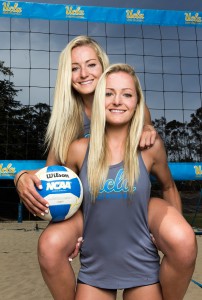A flash of blonde hair trails the 5-foot-9 volleyball player as she leaps through the air for a hit.
But is that number on her uniform 13 or 31? Better question: Is that Megan McNamara or Nicole McNamara?
Height, hair styles and facial features aside, the twins are also mirror images in terms of personality and even preferences. To the point where it’s not just other people who struggle to think of characteristics that set the twins apart.
“We get all the same grades, like the same things, dislike the same things,” Nicole McNamara said. “We’re very similar.”
It’s no coincidence that even the one ostensible difference was deliberately made to be as similar as possible.
“We specifically chose the numbers 13 and 31 so that as they’re coming at you, you have to think to figure out which one it is,” said coach Stein Metzger.
Those numbers help shroud an arguably more tangible distinction that sets the Canadian twins apart. This significant difference also allows them to work better as partners on the court.
Stories like “The Prince and the Pauper” and “The Parent Trap” have popularized the idea of two people with identical appearances trading places, but the McNamara twins have never been able to explore that option.
Growing up in a small high school community in Vancouver, Canada, definitely played a role in that, but once either sister picks up a pen or a fork, the jig is up.
One sister is left-handed and the other right-handed. Megan hits with her right hand while Nicole hits with her left, creating a difference that ironically helps them sync better as partners.

“It makes sense to have your shoulder to be on the inside between you and your partner,” Metzger said. “It’s definitely a significant advantage.”
Nicole and Megan McNamara’s opposite dominant hands open doors to a partnership that is arguably more effective than a righty-righty or left-lefty duo.
Under windy conditions or after an inevitable bad pass, this combination allows for better adaptability in handling out-of-system sets. In addition, the sisters’ different hitting arms also allow them to set each other up for option plays – opening up the possibility for the other partner to elect between setting or hitting on a second touch.
As much as their different hitting arms enhance their ability to play with each other, that is ultimately just an added layer above a deeper connection.
The McNamara sisters have occasionally competed with partners other than themselves. But whenever it’s time for bigger tournaments, they resume the partnership they first fostered during a family vacation to Puerto Vallarta, Mexico, many years ago.
“Just the fact that it’s so familiar, ’cause we’ve played together for so long that it just feels comfortable,” Megan McNamara said. “We’re able to be hard on each other and push each other. We’re not afraid to say how we feel.”
Successes such as a silver medal in the 2014 Youth Olympic Games in Nanjing, China, have served as a testament to their understanding on the court. Metzger’s goal is to take that foundation to the next level at UCLA.
“We’ve actually had to work on their (verbal) communication quite a bit, because it seems like they have this sixth sense of each other,” Metzger said. “But we feel that communication could help them even more.”
The prospect of having an identical sibling who can understand you better than anyone else is so tantalizing – even to a coach whose career highlights include three NCAA championships and a trip to the Olympics.
“I actually have thought of that before,” Metzger said. “At one point I was playing indoor and I wished I had five (identical brothers) to play with.”
That will never be a problem for the McNamara twins. They will keep opponents second-guessing for their entire playing careers.
